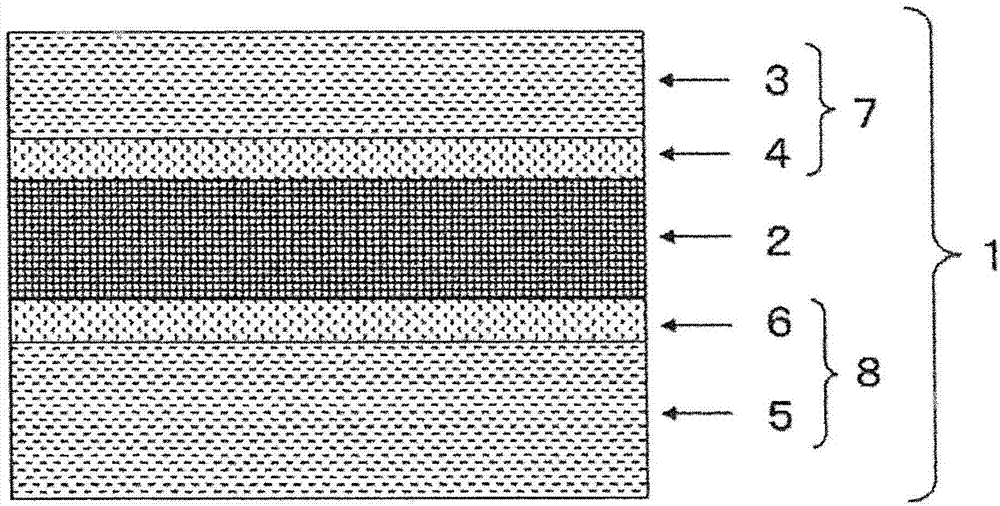Mold release film
A release film, mold layer technology, applied in the direction of film/sheet adhesive, film/sheet without carrier, coating, etc., can solve the deterioration of transferability, contamination of adhesive, and contamination of bonding process and other problems, to achieve the effect of good mold release, low transferability and high value
- Summary
- Abstract
- Description
- Claims
- Application Information
AI Technical Summary
Problems solved by technology
Method used
Image
Examples
no. 1 approach >
[0022] The polyester film referred to in the present invention refers to a film obtained by stretching a sheet melt-extruded from an extrusion port by a so-called extrusion method.
[0023] The polyester constituting the above-mentioned film refers to a polymer containing an ester bond obtained by polycondensation of dicarboxylic acid and diol or hydroxycarboxylic acid. Examples of the dicarboxylic acid include terephthalic acid, isophthalic acid, adipic acid, azelaic acid, sebacic acid, 2,6-naphthalene dicarboxylic acid, 1,4-cyclohexanedicarboxylic acid, and the like; Examples of diols include ethylene glycol, 1,4-butanediol, diethylene glycol, triethylene glycol, pentaerythiol, 1,4-cyclohexanedimethanol, polyethylene glycol, Diol and the like; p-hydroxybenzoic acid, 6-hydroxy-2-naphthoic acid and the like can be exemplified as the hydroxycarboxylic acid. Typical examples of such polymers include polyethylene terephthalate, polyethylene 2,6-naphthalate, and the like.
[002...
no. 2 approach >
[0090]In the present invention, the polyester film constituting the two types of release films (hereinafter, the one with the smaller release force may be referred to as the first release film, and the one with the larger release force may be referred to as the second release film) may be a single The layer structure may be a laminated structure, for example, in addition to the 2-layer or 3-layer structure, it may also be a multilayer of 4 or more layers within the limit not exceeding the gist of the present invention, and is not particularly limited.
[0091] The polyester used for the polyester film in the present invention may be homopolyester or copolyester. When composed of a homopolyester, a polyester obtained by polycondensation of an aromatic dicarboxylic acid and an aliphatic diol is preferable.
[0092] Examples of aromatic dicarboxylic acids include terephthalic acid and 2,6-naphthalene dicarboxylic acid, and examples of aliphatic diols include ethylene glycol, diet...
Embodiment 1-1
[0298]
[0299] The above-mentioned polyester (1) was supplied as a raw material to an extruder with a vent, and after being melted and extruded at 290°C, it was solidified by cooling on a cooling roll whose surface temperature was set at 40°C by electrostatic application encryption. , an amorphous film with a thickness of about 550 μm was obtained.
[0300] This film was stretched 3.7 times in the longitudinal direction at 85° C., stretched 3.9 times in the transverse direction at 100° C., and heat-treated at 210° C. to obtain a biaxially stretched polyester film with a thickness of 38 μm.
[0301] On the obtained polyester film, the release agent including the release agent composition-A shown below was applied in an amount (after drying) of 0.12 g / m 2 Coating was performed by a reverse gravure coating method, and a roll-shaped release polyester film was obtained under the conditions of a dryer temperature of 150° C. and a line speed of 30 m / min.
[0302]
[0303] · a1:...
PUM
| Property | Measurement | Unit |
|---|---|---|
| particle size | aaaaa | aaaaa |
| peel strength | aaaaa | aaaaa |
| peel strength | aaaaa | aaaaa |
Abstract
Description
Claims
Application Information
 Login to View More
Login to View More - R&D Engineer
- R&D Manager
- IP Professional
- Industry Leading Data Capabilities
- Powerful AI technology
- Patent DNA Extraction
Browse by: Latest US Patents, China's latest patents, Technical Efficacy Thesaurus, Application Domain, Technology Topic, Popular Technical Reports.
© 2024 PatSnap. All rights reserved.Legal|Privacy policy|Modern Slavery Act Transparency Statement|Sitemap|About US| Contact US: help@patsnap.com










